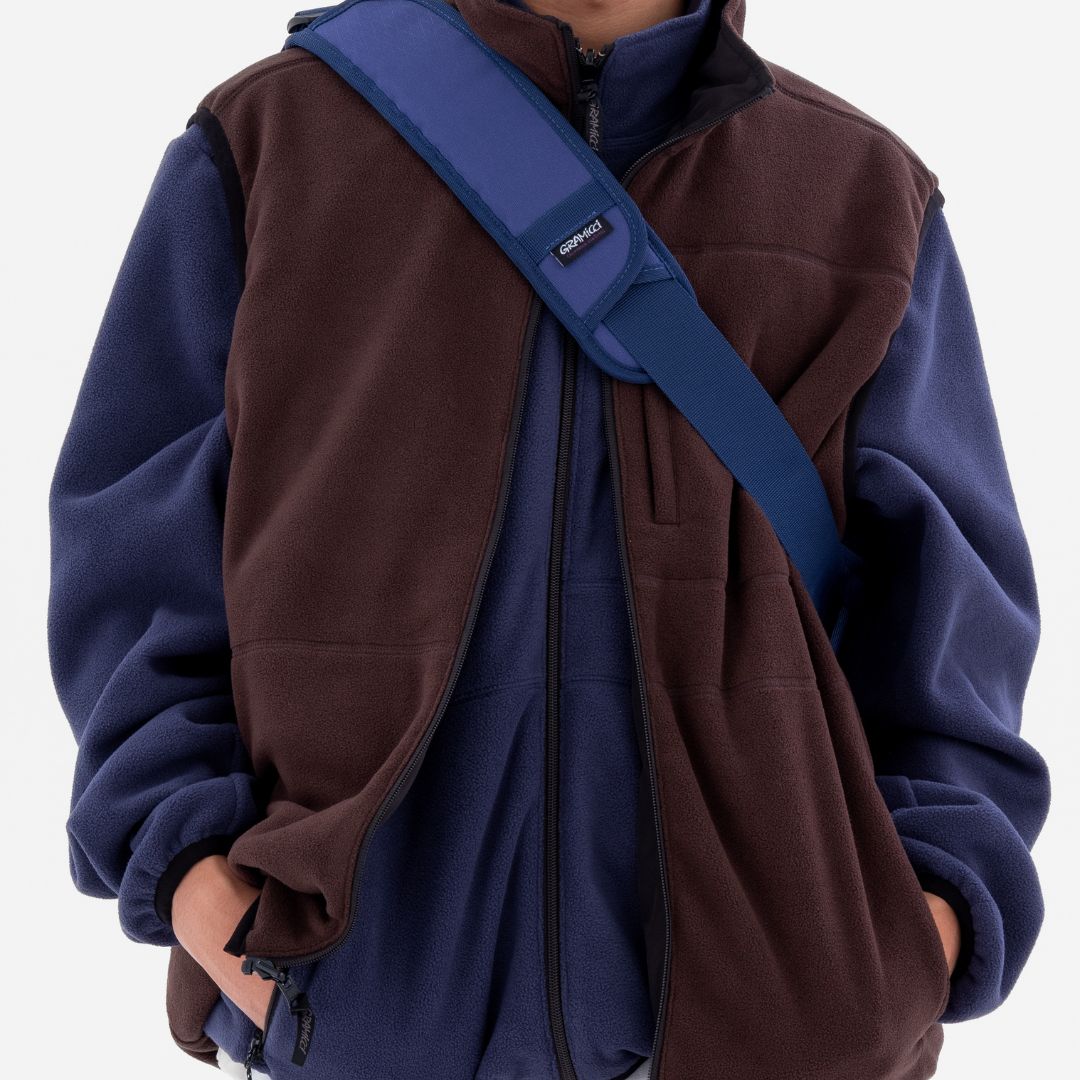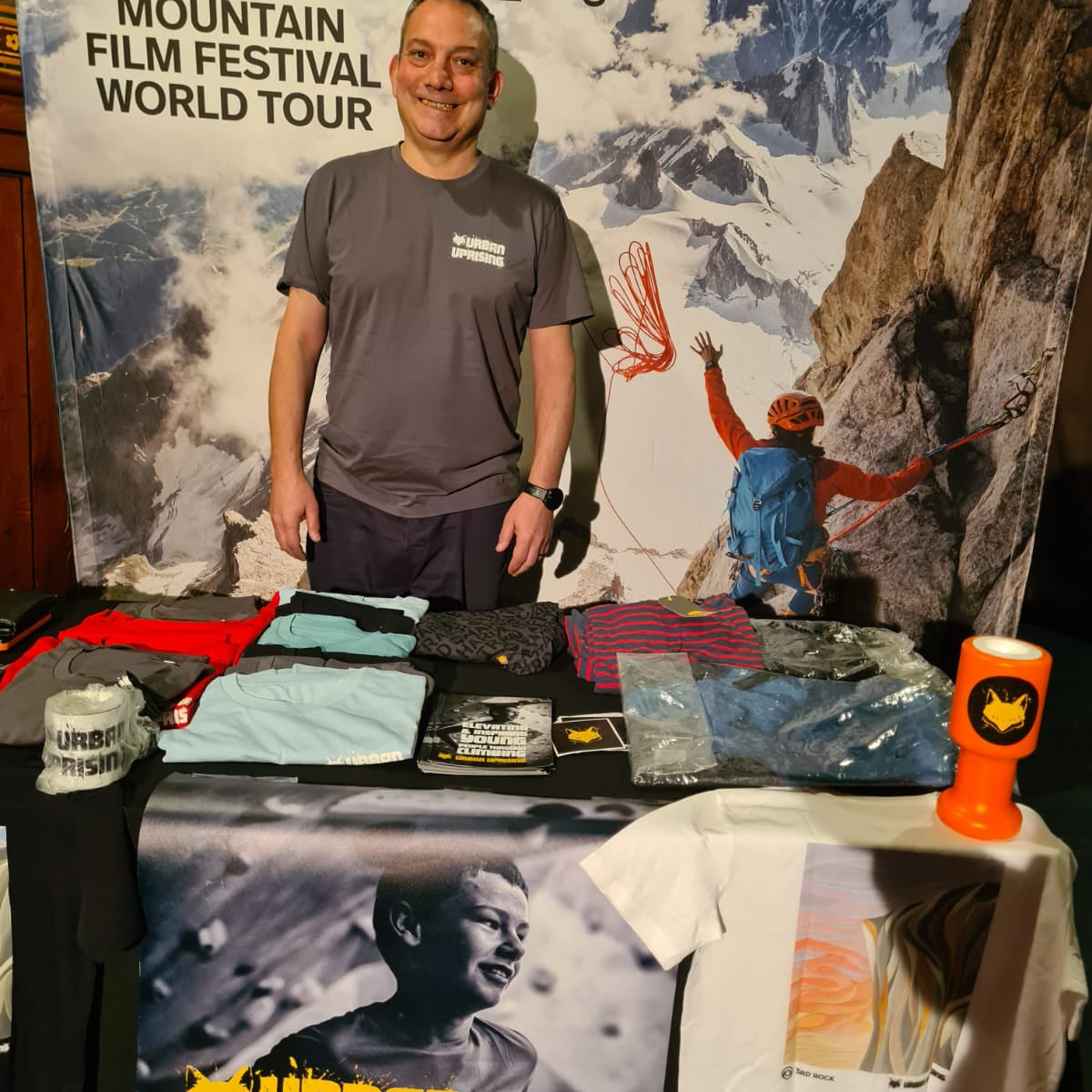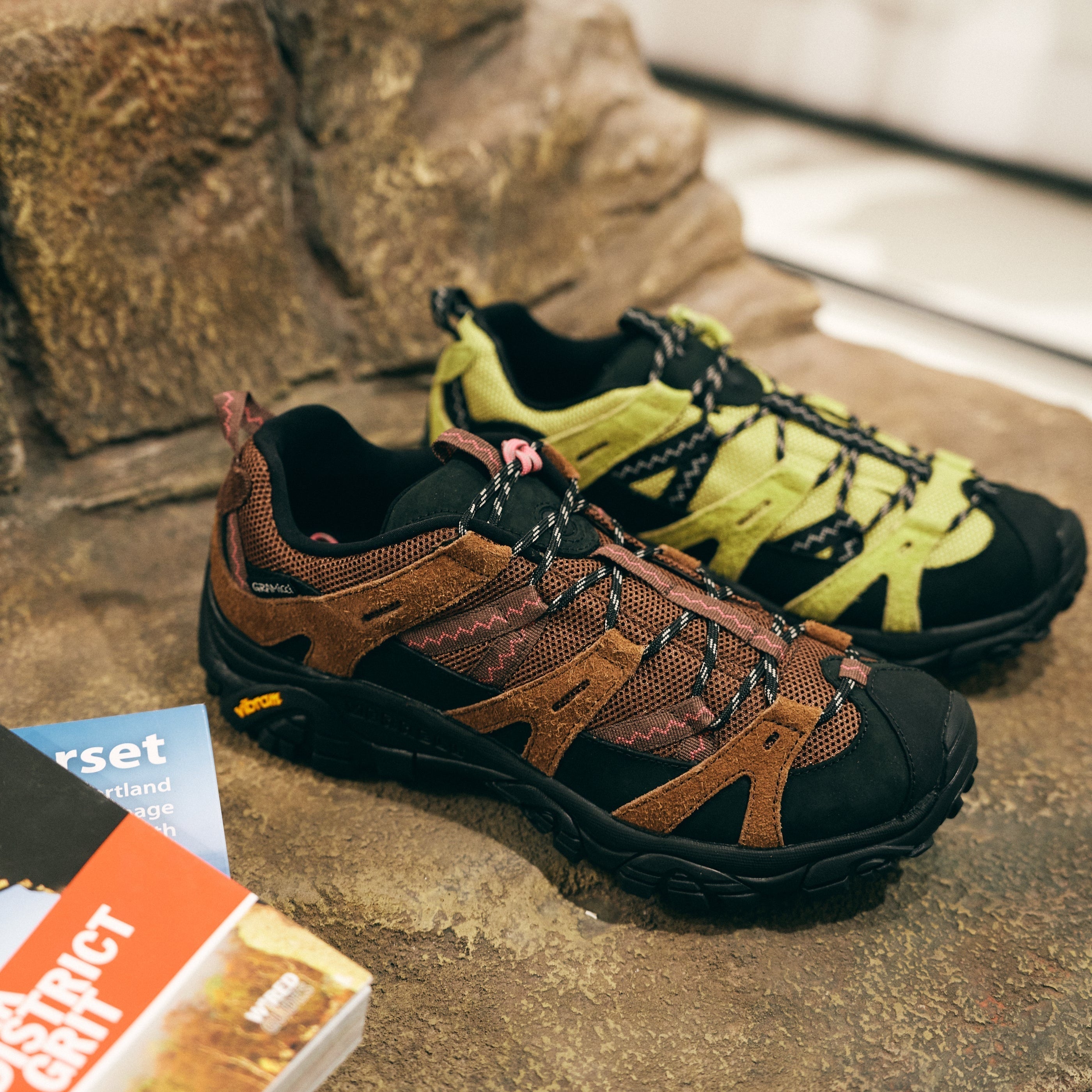Greater Goods is a London-based design workshop dedicated to turning ‘nothing into something’—transforming well-worn gear and fabric waste into new functional items that will be used for years to come.
They’ve worked with us a few times now; they repurposed old climbing pants into patchwork changing-room curtains for the London shop, and last year they gave a box of damaged Gramicci gear a new lease of life—turning it into a small range of military-inspired utility garb.
This season they’ve fired up the sewing machines once again—this time creating a limited collection of navy workwear out of old Gramicci garb. Crafted with serious care and precision—the GG Lucas Jacket and GG Gadget Pants here have a crisp, clean character rarely seen in the upcycling world.

With the raffle launching on Thursday the 20th of November for Collection 02, we called up Greater Goods founder Jaimus for a conversation about clothing, creativity and the importance of making things in the physical world…
Looking through all the projects you do with Greater Goods—there’s always a very strong theme or aesthetic for each one. What comes first for you—do you start with the concept already figured out, or does the idea come once you start taking the old pieces apart?
It depends on the project, but for this specific collection, we had the idea in mind first. We were using cotton twill trousers which are made of large pattern pieces that are quite simple to work with as it can be used to create large segments.. We wanted to make something that was incredibly clean, to the point that you couldn’t tell that it was upcycled. I think in upcycling it's harder to make something that doesn't look upcycled—so we gave ourselves that challenge.
It's quite easy to embrace the heavy DIY aesthetic, which we've done loads of times before. I’ve got nothing against it, but we wanted to test ourselves a bit more and make something that is a bit more tailored and clean.

Yeah—upcycling can often lean into that ‘home-made’ look, whereas this stuff is really professional and sharp.
It's just something we wanted to test ourselves with, and this seemed like a good opportunity to do it. The cotton is very forgiving, it irons nicely, it has a nice tone to it and it wears really well—so it was perfect for this.
The first collection we did with Gramicci was heavily embroidered and embellished—but we wanted to try something different. We've gone to the other end of the spectrum with this second collection.

What about the shapes themselves? It almost looks like a uniform.
It's essentially inspired by denim workwear. The trousers are based on Gramicci Gadget Pants, but we've changed the waistband to the traditional belt loop waistband. And then the jacket shape is taken from a vintage denim jacket that's cut quite short and cropped.
This whole collection is built on referencing classic workwear shapes and garments that are quite universal. With the jackets we've got sizes small, medium and large, with the linings of each jacket being totally unique.

You mentioned the challenge of making things that don’t look upcycled, but how was that in practice? Was that easier said than done?
Lucas, who worked on this, is a trained tailor, so this was very much his realm. It was a workflow that he's very familiar with—lining the jackets, finishing with hand stitching—it was tailoring.
I think the only tricky thing was making three things from small to large, all upcycled, all with the same paneling and shape. So the arms were actually cut in a way that it would look the same in a size large as it would in a size small. So doing the logistics of that was the trickiest bit, but even that wasn't mind-numbing—it just took a bit of extra planning.

That’s what strikes me as hard about designing clothes—it’s not like poster design or something that’s on paper—people are 3D, so getting that pattern right is so important.
Yeah—you can draw a whole city on paper, but I think once you go into the making, that's when the real test is. That's where the time is mostly spent. I don't like spending too long sketching and planning, I'd rather just get straight into making, because whenever we're sewing or physically making things, you do tweak and adjust.
I have a thing of just making two prototypes max, and then the third one is the final piece.
I'd rather make the commitment and be extra careful in the final fabric and adjust things as I go and kind of accept that’s how it's going to be, as opposed to making a big change. Because you can keep making prototypes until the next season—you can overwork something.

That ‘two prototypes only’ rule you have is interesting. It does often feel like overthinking and overworking something can get in the way of actually getting things done.
I think the standard is so high across the board in any kind of creative field now—there's a lot of pressure for everything to be incredible before it's seen by anyone, which is tough.
I suppose with social media even fun things can then kind of be rated and judged in terms of ‘success’. Does that stuff get in the way sometimes?
Yeah—you've got to develop a thick skin or some kind of approach that you stick to. Are you designing for Instagram, or are you designing for yourself? I speak about this with friends all the time.
I think maybe as soon as the numbers are assigned to something, it’s easy to think, “Oh, people seemed to like that one, I’ll do more of that.”
It's like there's a metric put to it and you can't avoid seeing the feedback from it. Sometimes it's not even a number—it's emotional feedback. If you get a dopamine hit from something, you're going to want more.
Definitely. Can you explain how you work on these projects? You get a big box of old bits—and at the end of it you’ve made some clothes… but what are the steps in between?
Yeah—so first we got a bunch of damaged Gramicci products—maybe they had ripped seams or were just heavily worn. Then we chose the best pieces, ironed them all flat, broke them all down and then just started working on the pattern.

Once we made the jackets, we actually felt they weren't distressed enough, so we got a pumice stone and started hand distressing them so there was a bit of texture. We kind of shot ourselves in the foot and the collection looked too clean—you couldn't tell it was upcycled, but to an extreme level—so the pumice stone really helped bring out the textures and the details.
Nearly all of the seams are triple stitched, which adds a crazy amount of strength and gives a bit of structure.

It’s interesting how the raw ingredients for this were the same as the last collection, but the end result is so different.
It's very different, but I kind of want to showcase that. I think upcycling often has this certain look, which I tried to break away from. And just as personal development as a studio, it was good to try something new. I don't want to be pigeonholed into like, “Greater Goods only does this.”
I like the flexibility and trying different things. I've tried so many different disciplines and I kind of still want to keep that going on internally under the umbrella of Greater Goods.
I was looking before to see when I last interviewed you and it was just over two years ago. What has changed for Greater Goods since then?
I think the standard is a lot higher in terms of general construction and we’re a lot more considerate—but in terms of creative thinking, I think it’s still the same, because it’s just from my brain, you know?
We're working on a few projects that are totally different—not just garments, but physical furniture and objects—so that's another phase of development.
I suppose you are kind of at odds with how the rest of this sort of the other fashion world works.
Yeah, it's so quick, and there are many people making things. You scroll Instagram and you think everyone’s going a thousand miles per hour. But I've kind of learned just to be in my own bubble and work at my own pace. It’s also important to have things outside of the studio space that keeps me creatively engaged, just so I don't get burnt out. I do love this, but I don't want it to drive me insane at the same time.

What do you do for that?
I do a lot of drawing. I used to draw a lot before all this and share them online. But I've kind of slowed down on the sharing in a sense. I kind of draw just for myself now.
It really depends how busy I am, but I like zine making as well—I love making printed media. I went to L.A. for a week last month, and I'm doing a little zine about that. I've stopped shooting film because it's so expensive, so I don't have these physical negatives or prints to look back on—so I’m making a little personal zine of my week in L.A. instead.
These things that aren’t necessarily tied in with Greater Goods, do they then end up influencing each other anyway?
Massively. Personal projects are the most important part of Greater Goods. These personal projects offer full creative freedom—they give you an excuse to try a new technique that you’ve been thinking about. It's our own R&D, but in the most fun way.

It was interesting you were saying you draw and you don't share online. Is that almost a thing of keeping it sacred?
I just don't want to be skewed, so I'm like, “Well, if I just don't share much of it, then I will just be more creative with it and not worry about it if it doesn't look perfect or the tones aren't correct.” It's like having a personal journal—you wouldn't scan that and upload it to Instagram.
It's just nice to have a few things that aren't shared—it just doesn't feel right to share a hundred percent of everything, you know? There needs to be something that is sacred to some capacity and I think the drawing is that for me.
That makes sense. And I suppose something meditative like drawing is kind of at odds with the internet and social media and attention. It’s meant to be relaxing.
Yeah, that's a good viewpoint of it. It is very lo-fi and it's meant to be meditative in some capacity, so it feels weird just flipping that on its head and just ruining that in a sense. It does take you out of the moment, doesn't it? It's like when you're in a big group of friends and your phone comes out, it just breaks that natural human connection.
What about when you’re making clothes—is that kind of ‘meditative’ too? Does your brain kind of shut off when you’re at the sewing machine?
It depends how smooth the project's going. If it's going really smoothly, and it's a good day, you definitely do get into this—dare I say it—’flow state’ where things are just working out and you don't check your phone. I always gauge it by if I need to check my phone, but it goes beyond that—if I'm having a good drawing session or I'm just into the flow of designing something, I'll forget to have lunch. I just get into that state of hyper-fixation.
I get a lot of satisfaction creating something that started off as essentially nothing—creating a physical object that functions and can be adapted and repaired. There's nothing more satisfying than making something physical, and I don't really get that from working on a screen. If I'm doing pure graphic vector work, I find it hard to get that same meditative experience, whereas on a sewing machine, where you have to be present and you have to be safe using it, you tend to hyper focus on it in the moment.
That makes sense. When you’re making things physically, there’s a tangible risk of something going wrong, isn't there—whether you cut your hands or you ruin some fabric. You don’t really need to focus the same way when you’re just clicking around on Photoshop.
It's a physical consequence—there's no going back, or if you do repair it, it’s going to change the aesthetic of it. We recently made a leather bag—and there was only room for one attempt—it had to be perfect.
But even then—if there were any mistakes, I’d probably just adapt it and change the design—it’s about problem solving, and I don't mind that whatsoever. I feel like that’s quite a fun part of the process. I've definitely had pieces in the past where I made a slight mistake, but we’ve always found ways to solve it.

Yeah, definitely. I think we kind of chatted for a while, I don't want to keep you too long. Rounding things off, where do you hope these clothes go? Do you think about where things end up?
The goal with the product is that it goes to people that will wear it and distress it more and put it through its paces, rather than treating it as a special one-of-one. I’d like people to wear it and not be precious with it. It's made from garments that already have a story, so it's nice to carry that on in some capacity. I feel that naturally they’ll fall into the right hands.
Learn more about the Gramicci by Greater Goods Collection 02 here.












